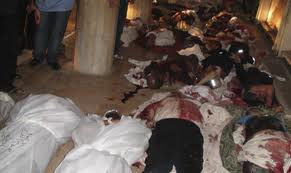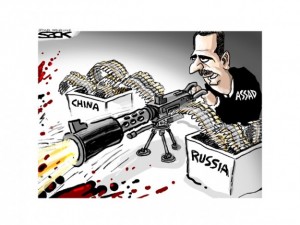 Beirut, Lebanon – Syria has strewn landmines along its borders with Lebanon and Turkey, making it the only country worldwide to use the weapons this year, and is increasingly dropping cluster munitions on civilian areas, campaigners said on Thursday.
Beirut, Lebanon – Syria has strewn landmines along its borders with Lebanon and Turkey, making it the only country worldwide to use the weapons this year, and is increasingly dropping cluster munitions on civilian areas, campaigners said on Thursday.
Nearly two dozen Syrians, many of them children, are known to have been killed or maimed by Soviet-made mines in border crossing areas so far this year, but the true number of casualties is probably higher, they said.
Another 10 children playing outdoors died in a government air strike that dropped cluster bombs on a rebel-held village near Damascus this week, they said.
“This year we have identified only one government that has used anti-personnel mines and that is Syria. We have information that the laying of mines has continued in Syria, with reports up to October this year that mines are being used,” Mark Hiznay, editor of the Landmine Monitor 2012 report, told a briefing.
The International Campaign to Ban Landmines (ICBL), which publishes the report, documented the most recent mine explosion last month in the village of Kharbit al Jouz, near the border with Turkey. Three civilians were injured, including two who lost their legs.
“This was basically a military position that was abandoned by the Syrian military one day and overnight they had laid about 150 to 200 landmines to delay whoever was pursuing them. And eventually the villagers started finding them the hard way as they were going about their business across the paths,” Hiznay said.
Syrian rebels are not known to have used landmines in the 20-month conflict aimed at toppling President Bashar al-Assad, but are setting off roadside bombs and other deadly devices, according to the Nobel prize-winning ICBL.
“We have seen instances where the insurgents are using improvised explosive devices but that all we have seen are ones that have been command-detonated, which is of a different character than an anti-personnel mine which is victim-activated,” Hiznay said.
Officials from 160 countries that have joined the Mine Ban Treaty meet in Geneva next week to review progress in halting production, destroying stockpiles and clearing mines after wars.
MADE IN THE USSR
 Russia has been a major ally and arms supplier to Syria but there was no indication of a recent transfer of mines to Assad’s forces, said Hiznay, a senior arms researcher at Human Rights Watch, which contributed to the report with four other groups.
Russia has been a major ally and arms supplier to Syria but there was no indication of a recent transfer of mines to Assad’s forces, said Hiznay, a senior arms researcher at Human Rights Watch, which contributed to the report with four other groups.
“The ones we have seen going into ground were produced in the Soviet Union in the 1980s, based on the markings that we have seen on the mines,” he said.
Human Rights Watch has also documented the use of cluster munitions by Syrian forces, including on an olive oil factory.
“These are indiscriminate, murderous weapons, they are using them for one reason and that is to attack the civilian population,” Hiznay told reporters.
Myanmar, long on its list of governments using antipersonnel mines, has been dropped this year as there has been no proven use by state forces, although armed groups have been found to being planting them there in 2012.
“The situation in Myanmar is evolving right now with the transition that’s going on there. Our ability to collect almost real-time information is somewhat limited,” Hiznay said.
Only four countries – India, Myanmar, Pakistan and South Korea – are known to be actively producing mines, ICBL said.
China, Russia and the United States have stayed outside the so-called Ottawa pact and reserved the right to produce mines, although the Obama administration is reviewing its position.
Reuters
Leave a Reply
You must be logged in to post a comment.